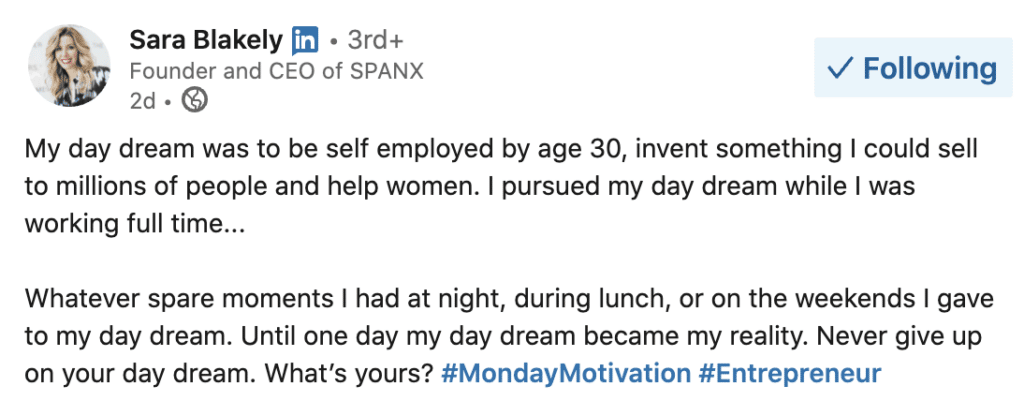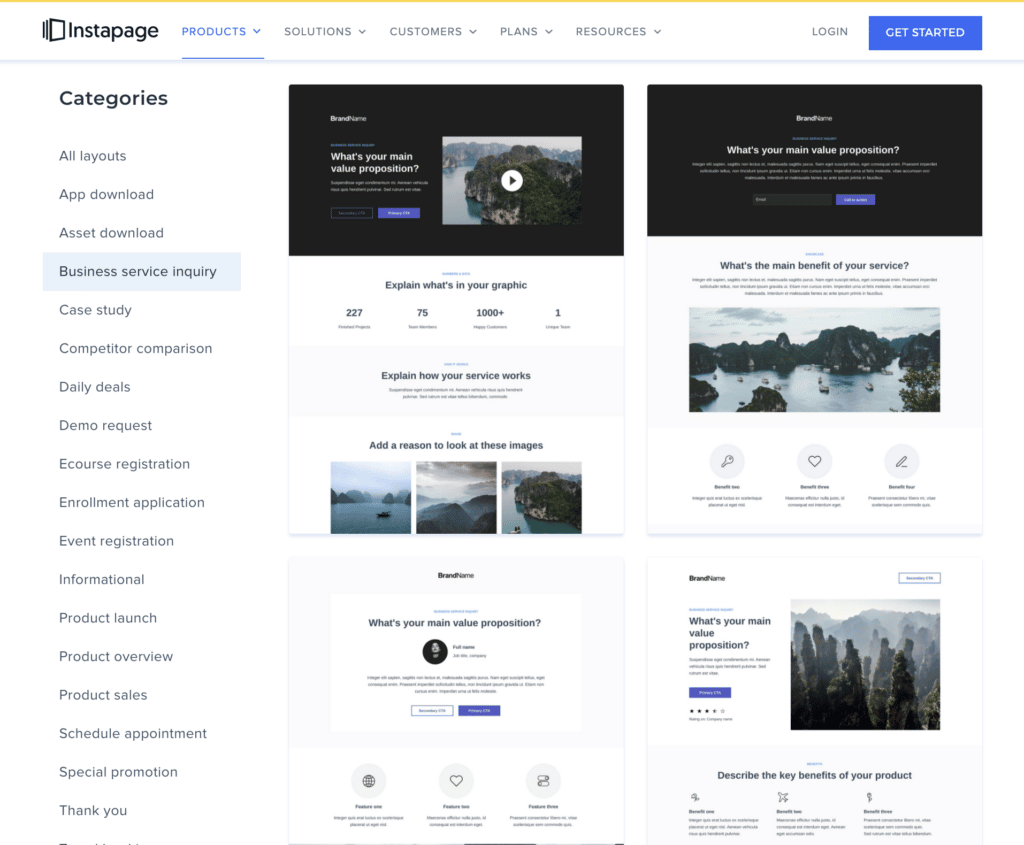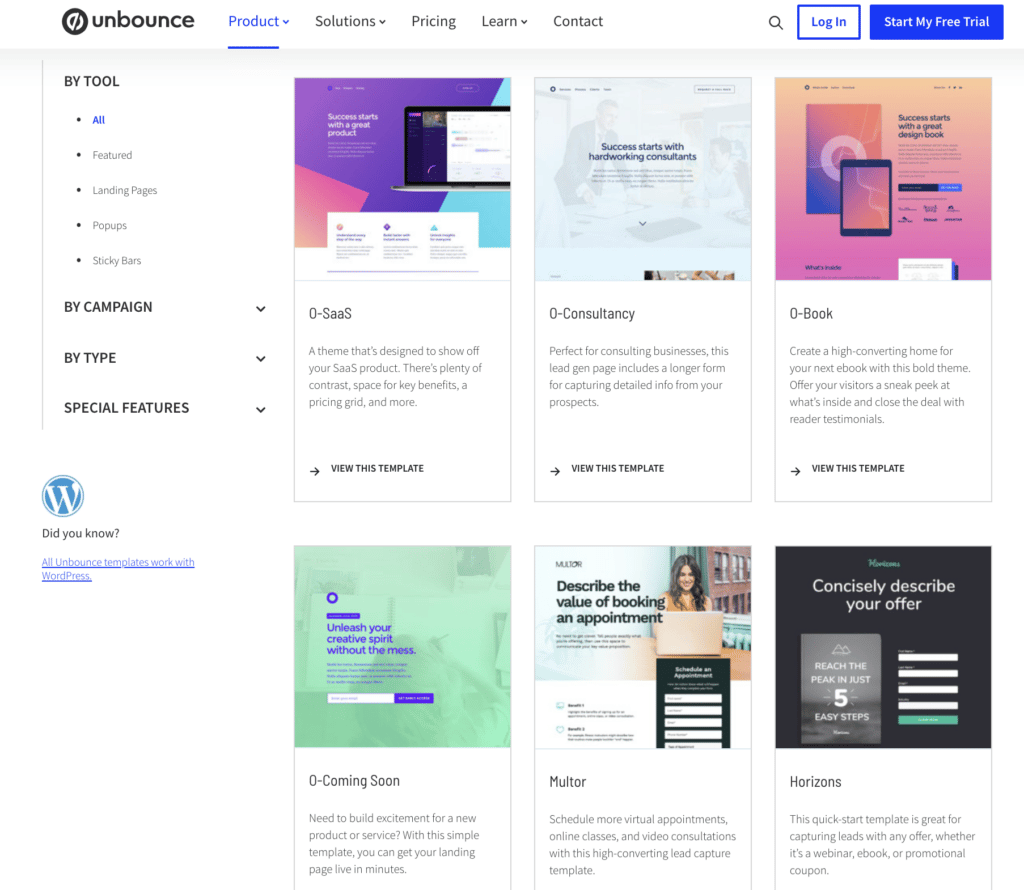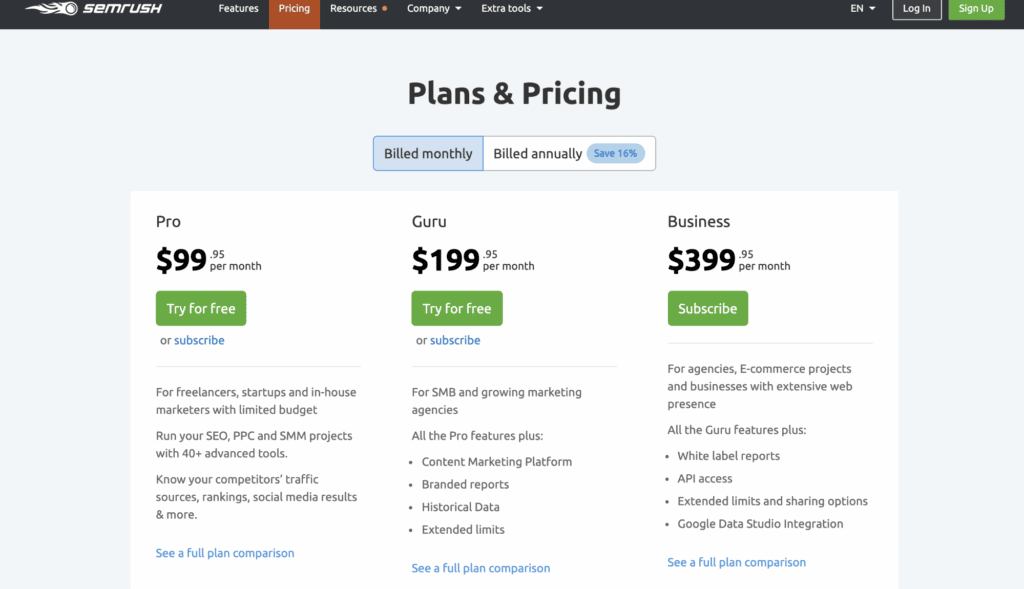Did you know that 50% of side hustlers are just thinking about getting started? The amazing thing about a side hustle is that you’re able to do it on your own time and actually focus on doing something you really love.
Recently, I came across this LinkedIn update by Sara Blakely, CEO and Founder of SPANX:

Here’s what resonated with me — and I’m sure with those who are working on starting their side hustle:
- You’re not afraid of working hard.
- You know what you enjoy doing and you want to make money doing it.
- You hold yourself accountable. In other words, your dreams don’t work unless you do.
- You’re not looking to get rich quick; you want to find a real way to generate revenue.
- You want to invest in yourself.
Whatever your side hustle (or day dream) is, you have the ability to make it a reality so long as you choose to do so. It’ll always be easier to make excuses as to why you can’t get started than to actually just get started. Also, know that feeling “motivated” isn’t the only thing that’s going to drive you to that six-figure side hustle. In fact, it’s really going to have to come down to your daily routine and how disciplined you are.
That said, in today’s blog I’ll walk you through some clear ways you can start your side hustle and what you need to keep top of mind.
Create a Website
Having a place where you can direct traffic is going to be an important part of your side hustle. Your website is going to serve as a way for potential and existing customers to get in touch with you. You’ll also be able to use it to funnel in visitors who may be interested in what you are selling and provide a clear call-to-action (CTA) that will generate revenue.
Here’s why having a website is imperative to your success:
- The average revenue for a small business is $3.6 million, but the average revenue for a small business with a website is $5.03 million. (Source)
- 46% of consumers in the study based their decisions on the credibility of websites on their visual appeal and aesthetics. (Source)
- Nearly 8 in 10 customers would stop engaging with content that doesn’t display well on their device. (Source)
- 62% of companies that designed a site specifically for mobile experienced an increase in sales. (Source)
So where do you start with your website?
The top elements I recommend for your website are a homepage, about page, contact page, and a blog. Of course, if you are looking to sell actual products, then you would want an e-commerce functionality (i.e. a shop page) as well. Here are the steps to consider when creating your website:
Step 1. Register Your Domain
Figure out what domain name you want to buy and register. In other words, you need a place to actually host your website before you can start developing it. I recommend checking either BlueHost or DreamHost. I’ve used both and love their customer service, as well as the ease of getting your website up and running.
For BlueHost, you will see that their cheapest plan starts at $3.95/month and includes a free domain name. Simply go to www.bluehost.com and click the “Get Started” button. From there, you can choose the basic plan to start.

As for DreamHost, you can see that their basic plan is priced at $2.59/month. Once you click on the “Get Started” button, you’ll be able to get your domain registered.

Step 2. Design Your Website
This part is probably the most daunting, especially if you don’t have any web design experience. However, you’re in luck because there are a ton of awesome drag-n-drop tools available. You just have to decide which one is the right one for you. I’ll walk you through the options that I believe are worth it and make it easy to get started.
- Option 1. Consider Instapage. With templates ready to go, you don’t even have to think twice about HTML and CSS. You can choose one of their templates, set it up to live under the domain you registered, and go from there. Pricing for Instapage starts at $149/month.

- Option 2. Check out Unbounce. Similar to Instapage, you can do the same things, but at a cheaper price. Unbounce pricing starts at $80/month and is easy-to-use as well as intuitive. Plus, you can sign on now and get 20% off your first three months.

- Option 3. Should you decide to build your site using WordPress, you definitely need to consider Elementor. It has been a life-saver for me and has made making changes to my website super easy. The starting price is free, but I’d recommend you upgrade to at least the “personal” plan which is $49/month. It’ll be worth the money, especially because your website is going to be used so much to drive quality traffic and sales for your side hustle.

Make Marketing a Top Priority
Here’s the amazing thing about marketing — you can control how much you want to spend to promote your side hustle. It’s all about finding the right marketing mix that works for you, optimizing it, and getting the most out of every dollar you spend.
More specifically, focus on digital marketing and push to narrow down at least 3 tactics that you want to start off with. The biggest hurdle I see with side hustlers is that they think they should be doing it all. That’s just not true. I’m a big fan of starting small, making progress, optimizing where needed, then repeating and introducing new tactics you may want to test.
Three tactics worth starting off with would be email marketing, blogging, and SEO.
Why these three? Because they’re an easy point of entry for any side hustler. Let me elaborate:
Email Marketing
You’ll need a tool that can help you capture potential/existing customer information, especially their email addresses. Plus, you’ll want an easy way to communicate with them. Therefore, email makes the most sense.
Additionally, tools like HubSpot and Ontraport allow you to automate simple things like sending out autoresponders for new subscribers, customers, inquiries, or even if someone has abandoned their cart.
Both tools do similar things, but you can certainly check out their sites to figure out which one is going to work best for you from the start. Just a quick note, I do recommend Ontraport only because it is less expensive for everything you get, and when you’re just starting out, every dollar counts.
Other reasons why email marketing is a no-brainer tactic to start with:
- Email marketing has $44 ROI for every $1 spent.
- 44% of users check their email for a deal from brands.
- Successfully implemented retargeting emails drive 28.3% of all e-commerce revenue.
- Automated email messages see a 70.5% increase in open rates and 152% higher CTR.
Blogging
When I first started my side hustle, all I did was blog. This was how I built an email list, website traffic, leads, and sales. It took me a good 2 years to land my first 5-figure client that eventually led to a 6-figure deal. All in all, I ended up making about $1M off of that client as time went on.
Again, I spent 2 years blogging without anyone even really reaching out and wanting to work with me. It took time and effort. I made sure to make a commitment to providing value through my content, and it paid off.
That being said, here are specific blogging stats that you need to check out to see the importance it will play in helping you generate revenue for your side hustle:
- Businesses that blog experience twice as much email traffic as businesses that don’t.
- Each month, approximately 409 million people view more than 20 billion web pages.
- Companies that blog get 97% more links to their websites.
- Businesses that prioritize blogging are 13x more likely to have a positive ROI on their efforts.
- Blogs that post daily get five times more traffic than those that don’t.
SEO
As you blog and generate more website traffic, you need to make sure that you are writing about topics that are being searched for and that the traffic coming to your site are potential customers. Managing these keywords and website traffic should be at the forefront of your SEO strategy.
Additionally, Google implements “core updates” with its algorithm that will make sure they are pulling relevant and authoritative content per the searcher’s intent. Therefore, making sure that you keep your target audience top of mind while crafting content should be a priority.
A top tool I turn to that helps me figure out trends, what competitors are doing, content that’s working well, etc. is SEMRush. More specifically, I use it regularly to figure out which keywords have enough search volume that makes it worth me writing a blog about.
That’s the beauty of leveraging a tool that gives you data-backed findings that you can then use to your advantage. That way, you are sure that the topics you are blogging about are relevant and have the ability to convert readers into paying customers.

Moving Ahead
As a side hustler myself, I’ve always gone with the approach of “this is a marathon, not a sprint.” Being too eager to just make money can cause your side hustle to suffer so that you forget to really add value.
Know that there are a ton of opportunities for you to capitalize on out there — however, it all comes down to the value you are able to put out. That’s where you will find that chasing your passion and turning it into a side hustle will then generate revenue.
Finally, remember that these two big steps (i.e. creating a website and pushing the right marketing mix) are key to getting started with your side hustle. You need a place people can go to learn more about what you have to offer and then you need tactics that will support that and more.
Disclosure: Please note that some of the links above are affiliate links. I only recommend products and services that I use and stand behind, and if you decide to try them, I will earn a commission at no cost to you. Doing so helps me run this blog and provide free content for you, my readers.






4 Responses